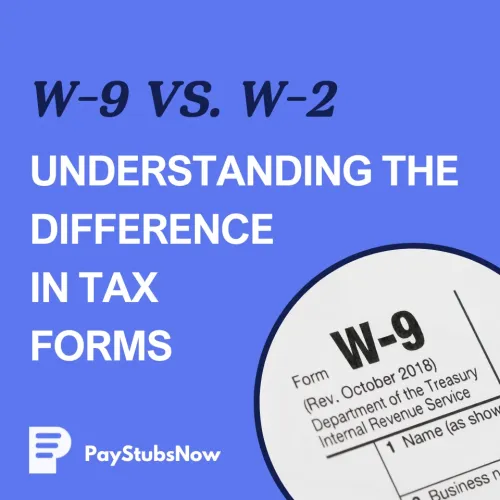


Understanding different tax forms is essential for business owners to ensure smooth operations and avoid headaches come tax season. Two of the most commonly used forms that you will encounter are the W-2 and the W-9. While both are important for tax purposes, knowing when to use each one is key to keeping your business compliant with Internal Revenue Service (IRS) requirements.
This article will break down the key differences between the W-9 and W-2, clarifying who needs to file them, their respective implications for tax reporting, and how businesses classify their workforce. We will also briefly explore how Paystubsnow’s platform can streamline the process of generating and managing these essential financial documents.

The Wage and Tax Statement, officially known as Form W-2 , is a document that employers provide to each employee by January 31st of the following year. This form details the total wages paid to the employee during the calendar year and the amounts of taxes (both federal taxes and state income tax) withheld from their paychecks. The W-2 also includes information about any contributions to benefits such as retirement plans or health insurance.
Form W-9 , or Request for Taxpayer Identification Number and Certification, is completed by independent contractors, freelancers, and other non-employee service providers to provide their Taxpayer Identification Number (TIN) to the hiring business. This TIN could be a Social Security number (SSN) for individuals or an Employer Identification Number (EIN) for businesses.
By submitting the W-9, contractors certify the accuracy of their TIN and confirm they are not subject to backup withholding due to previous underreporting of interest or dividends. The hiring business uses this information to report payments to the contractor on Form 1099-NEC or other relevant 1099 forms .
Understanding the differences between Form W-2 and Form W-9 is essential for businesses to accurately classify their workforce and fulfill their tax obligations. Here are some critical distinctions:
Form W-2 reports wages paid to employees and the taxes withheld from those wages. It ensures that both the employee and the government have an accurate account of the employee’s earnings and tax liabilities for the year.
Form W-9, on the other hand, is primarily an information-gathering tool. It allows businesses to obtain the necessary information from independent contractors to accurately report the payments made to them to the IRS via Form 1099.
Employers are responsible for completing Form W-2. They are required to fill out the form for each individual they have classified as an employee and paid wages to during the tax year.
Form W-9, on the other hand, is completed by independent contractors or freelance service providers and submitted to the business that is paying them. Once the W-9s are filled out and submitted, the businesses then securely store the forms in their databases.
For employees reported on Form W-2, employers are required to withhold federal income tax, as well as Social Security and Medicare taxes, from each paycheck. The amount withheld is based on the employee’s W-4 form, which they complete upon hiring.
Independent contractors reported on Form W-9 are not subject to income tax withholding by the paying entity. Instead, they are responsible for estimating their tax liability and making quarterly estimated tax payments directly to the IRS.
Employees must reference their W-2s when filing their federal and state tax returns. Since these forms include critical information, guaranteeing their accuracy is essential to avoid complications with the IRS.
At year-end, if contractors earn $600 or more from a single client, the client is required to report those earnings on a 1099-NEC form using the information provided on the W-9.
Employers are responsible for filing Form W-2 with the Social Security Administration (SSA), which then forwards the income tax information to the IRS. Employees use the information on their W-2 to file their individual income tax returns (Form 1040).
Businesses that receive Form W-9 from independent contractors use the information to prepare and file Form 1099-NEC with the IRS. The contractors use the information on the 1099-NEC to report their self-employment income on their tax returns.
 The IRS has specific criteria to help businesses classify their workers as employees or independent contractors:
The IRS has specific criteria to help businesses classify their workers as employees or independent contractors:
An employee works under a contract of employment that allows the employer to dictate when, where, and how the work is performed, for which the employer typically provides tools, equipment, and training.
An independent contractor, however, works on a project basis without ongoing commitments and has more control over how and when they perform their services. They often use their own tools and equipment and may work for multiple clients.
As mentioned earlier, employers withhold taxes from employee wages, while independent contractors are responsible for their own estimated tax payments, which cover income tax and self-employment tax ( Social Security and Medicare taxes ).
Employees are often eligible for benefits like healthcare, retirement plans, and sick leave, while independent contractors do not receive any such benefits and are responsible for their own health insurance and retirement savings.
 Businesses need to follow some important steps when classifying workers to ensure compliance with legal and tax regulations. The steps are as follows:
Businesses need to follow some important steps when classifying workers to ensure compliance with legal and tax regulations. The steps are as follows:
The IRS uses a common-law test to determine worker status. This test generally considers three specific aspects:
While a written contract can specify the worker’s status, the IRS will look beyond the contract to the actual working relationship.
The worker is required to work specific hours or days and must perform the work on the employer’s premises.
The worker is subject to close supervision and detailed instructions.
The worker is paid a regular wage or salary.
The employer provides most of the tools and materials.
The worker is entitled to employee benefits.
The relationship is ongoing rather than project-based.
Indicators of Contractor Status:
The worker has significant control over how and when the work is performed.
The worker can work for multiple clients.
The worker uses their own tools and equipment.
The worker is paid a flat fee for a specific project.
The worker is responsible for their own expenses.
The worker operates under a written contract that clearly defines the project and deliverables.
Worker classification mistakes can be costly. Using IRS guidelines, correctly distinguish between employees and contractors to avoid penalties. Verify details like control level and relationship nature and regularly update classifications to ensure compliance and reduce financial repercussions.
 Misclassifying employees as independent contractors carries substantial risks, especially for small businesses with limited resources. These can take the form of:
Misclassifying employees as independent contractors carries substantial risks, especially for small businesses with limited resources. These can take the form of:
The IRS can impose hefty penalties for failing to withhold and pay employment taxes and for failing to file accurate information returns (like Form W-2). These penalties can include fines and interest on the underpaid taxes.
Misclassified workers may have grounds to hold the company liable for a large sum of money because they were denied employee benefits. The company might be required to pay back wages and overtime pay and provide all those benefits that it had previously withheld.
Many states have their own laws regarding worker classification, unemployment insurance, and workers' compensation. Misclassifying employees can lead to a number of complications, including liability for failure to comply with local labor laws and hefty state-level penalties. So, if you are a business owner, misclassifying your workers is generally not worth the risk.
Businesses with a high number of independent contractors relative to employees may be at a higher risk of an IRS audit focused on worker classification. This imbalance raises questions about worker classification, increasing the likelihood of costly penalties.
Being found to have misclassified workers can damage a company’s reputation among employees, contractors, and the public. A damaged reputation can lead to difficulties in recruitment and retention, ultimately affecting the company's performance and ability to maintain relationships in the industry.
Paystubsnow's payroll documentation platform makes life easier for independent contractors and businesses by simplifying record-keeping and tax compliance. The platform offers a suite of services to:
Paystubsnow enables the easy creation of professional and accurate paystubs. These paystubs clearly detail gross wages, tax and benefit deductions, and net pay, providing both employees and contractors with a transparent record of their earnings and withholdings.
Paystubsnow streamlines the year-end tax reporting process by enabling businesses to generate both W-2 forms for their employees and 1099 forms for independent contractors. The platform ensures that all necessary information is included and formatted correctly.
The platform helps businesses and contractors create organized records of payments and earnings in minutes. For independent contractors, having well-documented income records is necessary for accurately calculating estimated taxes and deductible business expenses.
Paystubsnow is designed to generate documents that meet IRS requirements. This helps businesses and contractors avoid common errors and ensures that the information provided to the IRS is accurate and complete.
Properly classifying workers as employees or independent contractors determines which tax forms are required and what your tax obligations are. Businesses can avoid costly misclassification errors by following IRS guidelines and paying careful attention to the nature of the working relationship.
Using software like Paystubsnow can greatly simplify the process of generating pay stubs, W-2 forms, and 1099 forms, while also helping you maintain accurate financial records. The platform offers solutions that make it easier to manage tax paperwork and ensure tax compliance, whether you’re a business handling employee payroll or an independent contractor tracking earnings.
So, leave your tax worries behind and switch to Paystubsnow for efficient handling of business-related tax documentation
Generate W-2 Form !